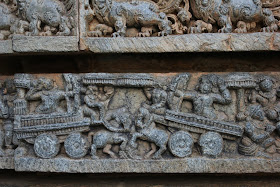Keshava temple is a perfect example of Hoysala architecture. It stands on a raised platform in the centre of a spacious enclosure having 64 cells. The temple is Trikutachala, meaning it has 3 Garbha Grihas (sanctums), 3 Antaralas and a Navarang. The 3 sanctums are located West, South and North, one each for Keshava, Venugopala and Janardhana.
All 3 are connected. Its an ornately carved temple of magnificient craftmanship depicting Vishnu, Lakshmi, Saraswati, Ganesha, Rati, Manmatha and Mahishasuramardini. The ceilings and door jambs leading to the sanctum sanctorium are exquisitely carved.
The base of the outerwall is ornamented with friezes of elephants, scrolls, epic and Puranic scenes, small images with intervning turrets and columns with figures in between, number of Gods and Goddesses and their attendents. The lathe turned pillars and delicately carved sixteen different types of ceilings are the characterstic feature of the Hoysala art. Names of number of sculptors- Mallithamma, Masanathamma, Chameya, Bhameya, etc. -are carved on the pedestals of the images. It is observed that Mallithamma has not only carved the maximum number of images but also carved the Northern sanctum of Janardhana.
There are inscriptions engraved on a slab standing at the entrance, inside the temple dated from 1269 to 1550 AD that details the construction of the temple and grants made to it.
There's the inscription, it's right there as soon as you enter the temple gateway.


Three Shikharas

Temple's main door with Dwarapalakas on either sides.

Multiple layers in every section of the structure are aligned perfectly. The North Shikhara

and West Shikhara.

The ceiling looks like wood-work; is it just for aesthetics or does it have a function.

Perfectly symmetrical, straight lines and right angles. I wonder what type of measuring instruments engineers of those days possessed to achieve this precision.

Layers of the lower section, starting from bottom-
* battle elephants
* cavalry
* floral art
* foot soldiers
* miniature columns and figurines
* miniature shikharas
* miniature columns and panels in between

Guides say that no two elephants or horses or any of the characters are same. All are unique.
Looks like Vishnu in sitting position ...I'm not sure. On the left is a standing female drummer.

A woman with Chakra & Shankha. The conical buttoned object on the left looks like maize ear.

Looks like Lord Vishnu.

Lord Brahma.

No idea who this is. Do take a close look at the design below the elephant. It's amazing!

Of the hundreds of elephants, I picked these two because of the decorative covering on their backs.


The classic scene of Vishnu and Laxmi relaxing on Adisesha. like the way Adisesha's tail the sculptor has positioned. Notice various sea creatures depicted on the left. How did these sculptors fit so much of details in this much space.

Soldiers on horse-backs charging in a battle.

Looks like a precision machined made for a spaceship.

Art of creating illusions. I did not recognize this as a face until I saw...

from the corner. A scary face!

My love for wheels is the reason for capturing the following four scenes with ox and horse carts; a family traveling, a business man taking his ware to market, soldiers traveling in ox-cart and a archers in horse drawn chariots engaged in battle.




A mare and a pony in battle-field.

Camels.

Soldiers with rectangular shields.

The temple has countless such floral art work. A close look you'll know they are all different. Each one them are unique. How did the sculptors keep track of such details?





I was captivated by this scene of Mahishasura's slaying. This is very close to the temple's main door. I must have spent 15 minutes here.

Folds on the bison's back look so real. So do the horns, nostrils ...everything looks so real!

The rakhshasa's intestines are ripped out. Even the gory details are depicted so well.

Signature of the sculptor, reads like Mallithamma.

Temple has so much details that one can never claim to have seen everything in this temple.
I could be wrong in guessing identities. Please do correct me if any.
Keshava temple Coordinates: 12°16′33″N 76°52′54″E
.........